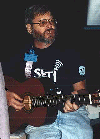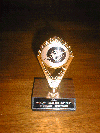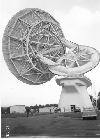|
 21 December 1996 |
|
 14 December 1996 |
| Caught in the act: executive director Dr. H. Paul Shuch committing premeditated music. This picture was taken at the Piled Higher and Deeper concert at the LAcon III World Science Fiction Convention in September, where Paul introduced his award-winning song The Rock That's From The Fourth Rock From The Sun. Stan Burns photo, © 1996, Southern California Institute for Fan Interests, Inc. |  7 December 1996 |
| The SETI League has won yet another trophy for science songwriting! Last November at Philcon, the Philadelphia Science Fiction Society's annual convention, we won second place for The SETI League Anthem. This year it's a first place for The Rock That's From The Fourth Rock From The Sun. See this Press Release for further details. SETI League photo |  30 November 1996 |
| Two years after its monumental Australian deployment, the Project Phoenix targeted search is underway again, this time from the NRAO 140 foot radio telescope at Green Bank, WV. This privatized SETI survey is being conducted by our colleagues at the California-based SETI Institute. SETI League photo |  23 November 1996 |
| The SETI League remembers Dr. Bernard M. Oliver (r) on the first anniversary of his death. Formerly Vice-President of Engineering for Hewlett-Packard Company, Dr. Oliver was one of the true SETI pioneers. He visited the National Radio Astronomy Observatory when Frank Drake was preparing to conduct Project Ozma in 1960, attended the first SETI meeting there a year later, headed the Project Cyclops study group in 1971, later directed NASA's SETI program, and served on The SETI League's initial advisory board. SETI League photo |  16 November 1996 |
| The late SETI pioneer Tony Wojtowicz with his SETI receivers and signal processing computer. Tony passed away just over a year ago. This equipment has been donated to The SETI League by the Wojtowicz family. Click here for additional photos of the Wojtowicz SETI station. Aline Wojtowicz photo |  9 November 1996 |
| This ten metre diameter dish is operated by the "Ricken-Sued" Swiss amateur group for radio astronomy, and soon, SETI. Click for more photos of this project. Photo courtesy of Alfred Wasser, SETI League volunteer coordinator for Switzerland
|  2 November 1996 |
| Close-up view of the dual feedhorns installed on the five metre SETI dish of Magin Casanitjana, EA3UM. These cylindrical waveguide feedhorns utilize choke rings per the VE4MA design, to improve illumination efficiency. Note that the hydrogen-line feed is slightly offset from center. This technique allows Project Argus participants to do parasitic SETI with a dish normally utilized for some other purpose. See related article. EA3UM photo |  26 October 1996 |
| While SETI League president Richard Factor looks on, administrator Heather Wood shows off his recent front-page photo in the Daily Record. The headline reads "League leads far-out hunt." Photo by Janet Kagan |  19 October 1996 |
| SETI League member Mike Gingell, KN4BS, at his North Carolina QTH, shows off his two dishes, 12 and 10 feet in diameter, used for radio astronomy, satellite TV, and of course SETI. KN4BS photo | 
12 October 1996 |
| SETI League member Daniel Fox has produced this System Block Diagram for amateur SETI, which has formed the basis for most of the stations assembled by our Project Argus pioneers. Dan's diagram is the centerpiece of our Technical Manual. Drawing by KF9ET | 
5 October 1996 |
| At the recent Bioastronomy '96 conference, SETI League Den Mother Muriel Hykes shares her favorite scholarly journal with SETI pioneer Dr. Philip Morrison. SETI League photo | 
28 September 1996 |
| Angelika Gerke, wife of Peter Wright, DJ0BI, the SETI League's coordinator for Germany, paints the European Radio Astronomy Club's 3 metre dish. Plans are to allocate this radiotelescope for SETI about 25% of the time. The Faraday cage below the antenna is an equipment housing, containing a computer-controlled IF receiver tuning 25 - 1000 MHz. Downconverters will be mounted at the antenna feed. DJ0BI photo |  21 September 1996 |
| This 7 metre diameter parabolic antenna is the handiwork of SETI League member and Project Argus participant Magin Casanitjana, EA3UM. Located in Spain, it went on the air on April 21, 1996, among the first operational Project Argus stations in Europe. EA3UM photo |  14 September 1996 |
| Anomalous signal detected by SETI League member Trevor Unsworth at 1471.5 MHz, using a homemade 3.5 meter dish. The signal exhibited digital modulation, with a 270 Hz bandwidth. Its Doppler shift of -25 Hz/min
marks it as RFI from a Low Earth Orbit (LEO) satellite. Though clearly not of extra-terrestrial origin, this signal gave Project Argus its first real workout, testing both the sensitivity of our receiving stations, and our ability to recognize terrestrial and satellite interference. See associated editorial. G0ECP image |  7 September 1996 |
| The reputed fossil evidence of microbial life from the Allan Hills meteorite, though genuinely exciting, is not entirely unprecedented. These electron microscope images by Hans Dieter Pflug, dating to the early 1980's, appear to reveal the presence of fossilized micro-organisms within the Murchison meterorite. Long considered controversial, Pflug's work now appears largely substantiated by the recent NASA find. Photos from Fred Hoyle, The Intelligent Universe, Copyright © 1983 by Dorling Kindersley Limited, p. 60 |  31 August 1996 |
| Planet hunter Michel Mayor (c) and his wife Francois join SETI League director H. Paul Shuch in a rousing chorus of the Pegasus 51 song. Dr. Mayor, of the Geneva Observatory, is the discoverer of 51 Pegasi b, the first planet detected around another sun-like star. At the BioAstronomy '96 Conference, he reported on his recent discovery of several Brown Dwarf stars. SETI League photo |  22 August 1996 |
| This 4.5 billion-year-old rock, labeled meteorite ALH84001, is believed to have once been a part of Mars and to contain fossil evidence that primitive life may have existed on Mars more than 3.6 billion years ago. The rock is a portion of a meteorite that was dislodged from Mars by a huge impact about 16 million years ago and that fell to Earth in Antarctica 13,000 years ago. The meteorite was found in Allan Hills ice field, Antarctica, by an annual expedition of the National Science Foundation's Antarctic Meteorite Program in 1984. It is preserved for study at the Johnson Space Center's Meteorite Processing Laboratory in Houston. NASA caption and photo Click for related photos. |  15 August 1996 |
| This high-resolution scanning electron microscope image shows an unusual tube-like structural form that is less than 1/100th the width of a human hair in size found in meteorite ALH84001, a meteorite believed to be of Martian origin. Although this structure is not part of the research published in the Aug. 16 issue of the journal Science, it is located in a similar carbonate glob in the meteorite. This structure will be the subject of future investigations that could confirm whether or not it is fossil evidence of primitive life on Mars 3.6 billion years ago. Caption and photo courtesy NASA |  7 August 1996 |
| SETI League executive director H. Paul Shuch (R) chats with radioastronomy pioneer Grote Reber (W9GFZ), in the shadow of his creation, the world's first true radiotelescope. KN4BS photo |  31 July 1996 |
Click here for lots more pictures.
email the Webmaster | entire website copyright © The SETI League, Inc. this page last updated 11 January 2003 |
Top of Page |
 SETI League Photo Gallery
SETI League Photo Gallery